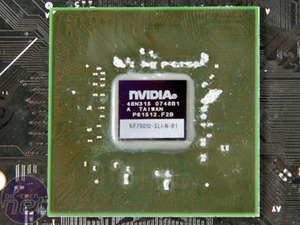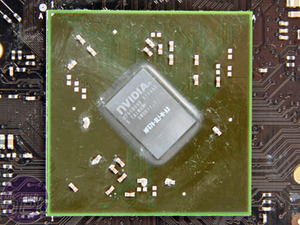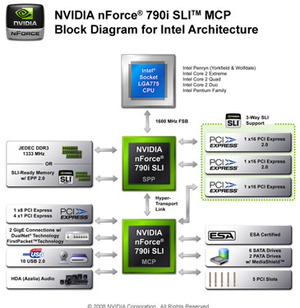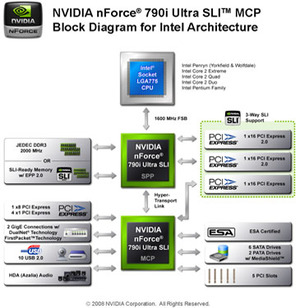First Look: Nvidia nForce 790i Ultra SLI
March 19, 2008 | 08:16

Nvidia nForce 790i series
Manufacturer: NvidiaThe Nvidia nForce 780i SLI might be only a few months old, but it only supports DDR2 memory and many were disappointed with nForce 780i SLI because it was nForce 680i SLI with a third chip.
With the fact that DDR3 has now been on the market for nine months, DDR2 motherboards are no longer considered ‘flagship’ by manufacturers – technology needs to move forwards, as they say. However, because DDR3 is maturing slowly and still disproportionately priced out of the market, DDR2-based motherboards are still the choice of many gamers and enthusiasts – you can’t argue at 4GB of fast memory for well under £100, can you?
That said, we’re slowly seeing more and more capable DDR3 memory rated to 1,800MHz, 2,000MHz and even beyond. Yesterday, Nvidia decided it was time to enter the DDR3 market with its next-generation “enthusiast” chipsets: the nForce 790i SLI and the nForce790i Ultra SLI. And this time around, the new chipset is just that.
Now, I know I’ve been heavily critical of the “enthusiast” brand on super-expensive parts and, after talking to Nvidia about the eye watering expected retail price, we were simply told that it didn’t expect to sell many – it’s meant to be an industry leader and a technical demonstration of what the company has in store for future DDR3 products. At least it’s honest about its sales projections, but that means the nForce 790i series chipsets are essentially designed for willy wavers across the world. It's a glimpse of what Nvidia has in store for the rest of us in the future, but it's worth noting that, conversely, this will likely be the last Nvidia chipset without an IGP - the nForce 790i series does not support Hybrid SLI.
Most of us will be looking at DDR3 in Q4 this year and into 2009 when prices are expected to drop, Nehalems will arrive on DDR3 only and DDR3-based AMD CPUs will be just around the corner. In this respect, DDR2 chipsets will be around for a while, but expect the nForce 790i series to demonstrate a level of performance that you can expect to see in future products that filter down to us normal folk.
If you’re seriously considering 3-way SLI or even Quad-SLI, then the nForce 790i series should be a definite consideration. While we’re only covering the technology today in our first look, in a future article we’ll see if the performance gain is worth buying over the nForce 780i SLI as well as other alternatives like the Intel X48 and X38 chipsets which feature support for CrossFire X.
What’s new in the nForce 790i series?
The Nvidia nForce 790i series comes in two flavours – the nForce 790i SLI and the nForce 790i Ultra SLI. The NF790IU north bridge is currently version A2 and is fabricated on a 90nm process in Taiwan (that’ll be either TSMC or UMC then, because Nvidia wouldn’t disclose this). This is still paired with the old NF570 south bridge that’s been around the block more than a few times – the version used here is the same as in the nForce 780i SLI which includes the new ESA support that is also officially launching with the nForce 790i series.Just to recap, the south bridge includes six SATA and one IDE channel with “MediaShield” storage technology, two physical layer Gigabit Ethernet connections with Nvidia “FirstPacket” technology and DualNet (network teaming), ten USB 2.0 ports, five legacy PCI slots and High-Definition audio support. The chipset is still manufactured on an old 130nm process which means it still runs very hot and still talks to the north bridge with a HyperTransport 1.0 x8 link running at 1GHz, providing 2GB/s of bandwidth. The south bridge still has four PCI-Express 1.1 x1 links and a single x16 link to provide some choice for board makers. For example, Asus might decide to make a workstation (WS) version with four or five x16 (x16-x16-x16-x8-x4?) lanes – in this way it wouldn't need to use extra board space and cost on an additional chipset.
Despite Nvidia’s insistence this is still a cutting-edge MCP south bridge we’re not convinced – it could desperately do with a die-shrink and 10 USB 2.0 lags behind the 12-14 found elsewhere. While the networking section are still feature packed, we feel six SATA is perhaps on the low side now – those buying this board will be early adopters so upgrading to SATA DVD-RW drives is hardly out of the question. The XFX board based on the reference design does include an extra chipset for eSATA and an additional SATA port, but that’s still an additional cost, board space and these connections can’ be incorporated with the MediaShield technology.

MSI MPG Velox 100R Chassis Review
October 14 2021 | 15:04












Want to comment? Please log in.